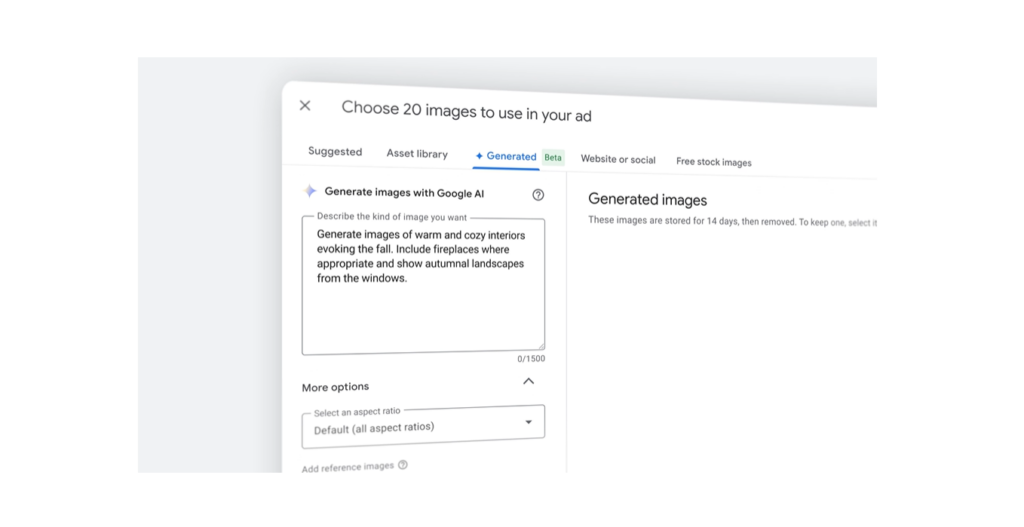At DMEXCO 2024, Google introduced a range of AI-powered updates to its Google Ads platform, designed to help advertisers better engage with their audiences and improve return on investment (ROI).
These updates focus on expanding language support, offering enhanced creative controls, and providing deeper insights to optimise campaign performance. The overall goal is to make AI-driven advertising more accessible and effective while giving advertisers greater control over their campaigns.
Creative Flexibility with Generative AI
In AI-powered advertising, having a wide variety and high volume of creative assets is crucial for achieving strong results. To support this, Google has expanded its AI-powered image editing tools beyond Performance Max campaigns, now including Search, Demand Gen, App, and Display campaigns. These features allow advertisers to customise and enhance image assets across more campaign types, making it easier to maintain visual consistency and optimise creative elements across different channels.
One of the key benefits of this update is the ability for advertisers to spotlight specific products by selecting and editing images directly from Google Merchant Center. Added control helps businesses fine-tune their visuals to better align with their brand identity and marketing goals. By enabling image customisation within Google’s ecosystem, the process of generating high-quality visuals becomes more streamlined, allowing these assets to be used across multiple campaign formats.
To further enhance the capabilities of global advertisers, Google is making its asset generation tools available in six additional languages: German, French, Spanish, Portuguese, Dutch, and Italian. Expanding into these regions enables businesses to more easily generate a diverse range of ad copy and images tailored to their local markets. Broader language support significantly extends the flexibility and reach of Google’s AI-driven creative tools. Whether it’s for Performance Max, Demand Gen, App, or Display campaigns, advertisers can now generate high-performing creative assets with less manual effort, ensuring their ads resonate with a more diverse audience.
Balancing AI with Human Creativity
While AI plays an increasingly prominent role in advertising, Google emphasises that its technology is designed to complement, not replace, human creativity. Advertisers can now submit up to five reference images alongside specific prompts, enabling AI to generate visuals that align more closely with their brand’s aesthetic. The AI-driven creative process still ensures that final outputs reflect the advertiser’s unique vision.
To maintain brand consistency, Google is rolling out brand guidelines for its Performance Max campaigns. Advertisers can upload essential brand elements, such as logos, fonts, and colour schemes, ensuring that AI-generated assets remain aligned with their branding across all ad formats. Combining AI-driven automation with human oversight allows advertisers to retain creative control while benefiting from the efficiencies of AI.
Improved Campaign Insights
Understanding campaign performance is a crucial aspect of effective advertising, and Google’s latest updates aim to provide advertisers with more actionable insights. The new asset-specific conversion metrics offer deeper visibility into which creative assets are driving results and which are underperforming, offering more data to inform campaign adjustments.
Google is also introducing asset coverage reporting for Performance Max, which highlights areas for improvement by suggesting additional headlines or images. These reporting tools are designed to simplify the optimisation process and help advertisers maximise their ad spend.
To make campaign management more efficient, Google is consolidating performance insights into a single view. The unified layout includes target pacing insights, enabling advertisers to monitor whether their campaigns are on track to meet key performance goals, such as cost-per-acquisition (CPA) or return on ad spend (ROAS). Real-time visibility into campaign performance allows advertisers to make quick adjustments to stay on course.
For the first time, Performance Max will feature impression share reporting, offering advertisers insights into how prominently their ads are appearing in Search results compared to competitors. Competitive insights will help advertisers better understand their market position and identify opportunities to increase reach.
Enhanced Control Over Campaigns
Google is introducing several new features to give advertisers more control over their AI-powered campaigns. By the end of 2024, advertisers using Performance Max will have the option to add campaign-level negative keywords. Greater control over search queries will ensure that ads are more closely aligned with the brand’s target audience.
In addition, Google is rolling out omnichannel bidding for Demand Gen campaigns, enabling advertisers to optimise for both online and in-store conversions. This feature allows businesses to capture customer intent more effectively across multiple platforms. Advertisers will also have the ability to purchase Demand Gen campaigns through Google’s Display & Video 360 platform, offering even more flexibility in managing their ad efforts.
AI Tools Expand Across Languages
Lastly, Google plans to extend its “conversational experience for Search campaigns” to additional languages. Previously available only in English, the feature will soon support German, French, and Spanish.
The conversational experience simplifies ad creation by allowing advertisers to input a landing page URL, after which Google’s AI generates keywords, descriptions, headlines, and images based on the page’s content.
Language expansion broadens the reach of AI-powered ad creation, enabling businesses in non-English-speaking regions to easily create optimised Search campaigns tailored to their local markets.
According to Google, companies like HomeToGo, a vacation rental marketplace, have already utilised the conversational experience to streamline ad creation, generating optimised headlines and descriptions. With this technology becoming available in more languages, businesses will be better equipped to reach their target audiences more efficiently and effectively.




RECOMMENDED FOR YOU
LinkedIn Streamlines B2B Influencer Marketing
LinkedIn has introduced a more intuitive way for brands…
LinkedIn has introduced a more intuitive way for brands…
Meta Adds New AI Tools To Supercharge Lead Gen
Meta is rolling out a wave of updates to…
Meta is rolling out a wave of updates to…
Meta Uses AI Chats To Refine Ad Targeting
Meta has announced a major update to how it…
Meta has announced a major update to how it…